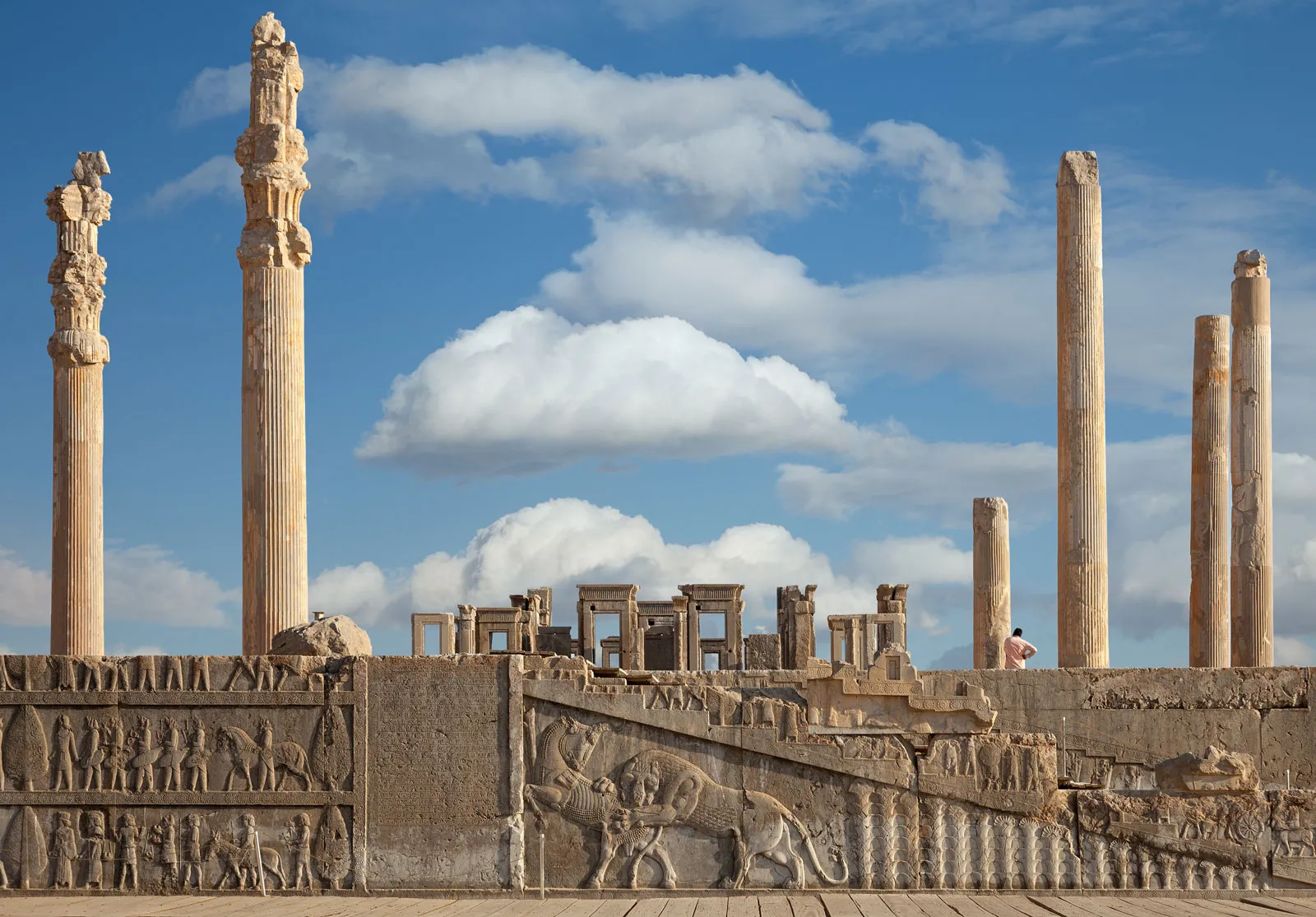Chapter 2: Ancient Near Eastern Art
Key Notes
- Time Period
- Sumerian Art : c.3500–2340 B.C.E.
- Babylonian Art : 1792–1750 B.C.E.
- Assyrian Art : 883–612 B.C.E.
- Persian Art : c. 559–331 B.C.E.
- Culture, beliefs, and physical settings
- Ancient Near Eastern art takes place mostly in the city-states of Mesopotamia.
- Religion plays a dominant role in the art of the Ancient Near East.
- Art-making
- Figures are constructed within stylistic conventions of the time, including the hierarchy of scale, registers, and stylized human forms.
- Cultural Interactions
- There are many similarities among artistic styles in the Ancient Near East, which indicates a vibrant exchange of ideas.
- Ancient Near Eastern artistic conventions influenced later periods in art history.
- Audience, functions and patron
- Ancient Near Eastern art concentrates on royal figures and gods.
- Ancient Near Eastern architecture is characterized by ziggurats and palaces that express the power of the gods and rulers.
- Theories and Interpretations
- The study of art history is shaped by changing analyses based on scholarship, theories, context, and written records.
Historical Background
- Ancient Near East is where almost everything began first: writing, cities, organized religion, organized government, laws, agriculture, bronze casting, and even the wheel.
- Between the Tigris and Euphrates Rivers, fertile river valleys saw the rise of substantial populations.
- Kings realized artists could boost their careers early on.
- Artists could enhance images, bring gods to life, and sculpt narrative tales that outlasted kings.
- They wrote in cuneiform and imprinted royal names on cylinder seals and relief sculptures.
- This began one of art history's most symbiotic patron-artist relationships.
Ancient Near Eastern Art
- Ziggurats: The first great buildings of the ancient world; were made of baked mud, and they were tall, solid structures that dominated the flat landscape.
- Lascaux: A network of caves near the village of Montignac, in the department of Dordogne in southwestern France.
- Lamassus: A Mesopotamian celestial being with a human head, bull's body, and wings.
- Cuneiform: a system of writing in which the strokes are formed in a wedge or arrowhead shape
- Laws were written down, taxes were accounted for and collected, and the first written epic, Gilgamesh, was copied onto a series of tablets.
- Apotropaic: having the power to ward off evil or bad luck
Sumerian Art
- Sumerian art: It has realistic-look-ing figures acting out identifiable narratives.
- Figures are cut from stone, with negative space hollowed out under their arms and between their legs.
- Negative space: empty space around an object or a person, such as the cut-out areas between a figure’s legs or arms of a sculpture
- Eyes are always wide open; men are bare-chested and wear a kilt.
- Women have their left shoulder covered; their right is exposed.
- Nudity: A sign of debasement; only slaves and prisoners are nude.
- Sculptures were placed on stands to hold them upright.
- Human heads and animal bodies were freely intermixed.
- Humans are virtually emotionless.
- Important figures are the largest and most centrally placed in a given composition.
- Such an arrangement is called the hierarchy of scale and can be seen in the Standard of Ur (c. 2600 B.C.E.) in which the king is the tallest figure, located in the middle of the top register.
- Hierarchy of scale: a system of representation that expresses a person’s importance by the size of his or her representation in a work of art
- In the Sumerian world, the gods symbolized powers that were manifest in nature.
- Local god: An advocate for a given city in the assembly of gods.
- It was incumbent upon the city to preserve the god and his representative as well as the king.
- Temple: Became the center point of both civic and religious pride.
➼ White Temple and its Ziggurat
Details
- c. 3500–3000 B.C.E
- Made up of mud brick
- Found in Uruk (modern Warka), Iraq
Form
- Buttresses spaced across the surface to create a contrasting light-and-shadow pattern.
- The ziggurat tapers downward so that rainwater washes off.
- Entire form resembles a mountain, creating a contrast between the vast flat terrain and the man-made mountain.
- Bent-axis plan: ascending the stairs requires angular changes of direction to reach the temple
Function
- On top of the ziggurat is a terrace for outdoor rituals and a temple for indoor rituals.
- The temple on the top was small, set back, and removed from the populace; access was reserved for royalty and clergy; only the base of the temple remains.
- The temple interior contained a cella and smaller rooms meant for the deities to assemble before a select group of priests.
- Cella: the main room of a temple where the god is housed
Materials
- Mud-brick building built on a colossal scale and covered with glazed tiles or cones.
- Whitewash: was used to disguise the mud appearance; hence the modern name of White Temple.
Context
- Large settlement at Uruk of 40,000, based on agriculture and specialized labor.
- Uruk: May be the first true city in history; the first with monumental architecture.
- Ziggurat sited within the city.
- Anu: The god of the sky, the most important Sumerian deity.
- Gods descend from the heavens to a high place on Earth; hence the Sumerians built ziggurats as high places.
- Four corners oriented to the compass; cosmic orientation.
Image
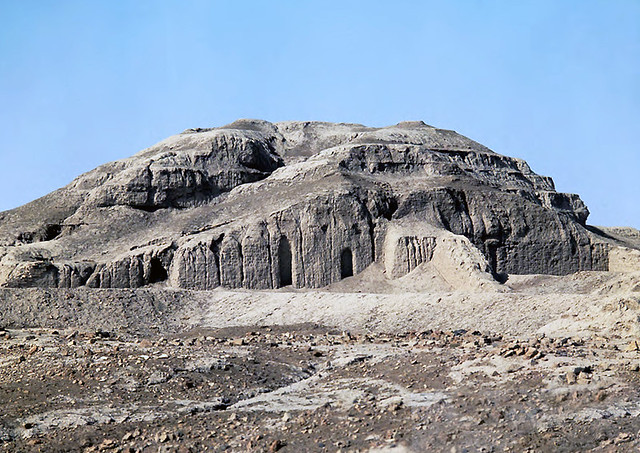
➼ Statues of Votive Figures
Details
- From the Square Temple at Eshnunna (modern Tell Asmar, Iraq)
- c. 2700 B.C.E.
- Gypsum inlaid with shell and black limestone
- Preserved in Iraq Museum ,Baghdad, and the University of Chicago, Chicago, Illinois
- Votive: Offered in fulfillment of a vow or a pledge
Form
- Figures are of different heights, denoting hierarchy of scale.
- Hands are folded in a gesture of prayer.
- Huge eyes in awe, spellbound, perhaps staring at the deity.
- Men are bare-chested; wearing belt and skirt; beard flows in a ripple pattern.
- Women are dressed draped over one shoulder.
- Arms and feet cut away.
- Pinkie in a spiral; chin a wedge shape; ear a double volute.
Function
- Some have inscriptions on the back — “It offers prayers.”
- Other inscriptions tell the names of the donors or gods.
- Figures represent mortals; placed in a temple to pray before a sculpture of a god.
Context
- Gods and humans physically present in their statues.
- None have been found in situ, but buried in groups under the temple floor.
Image
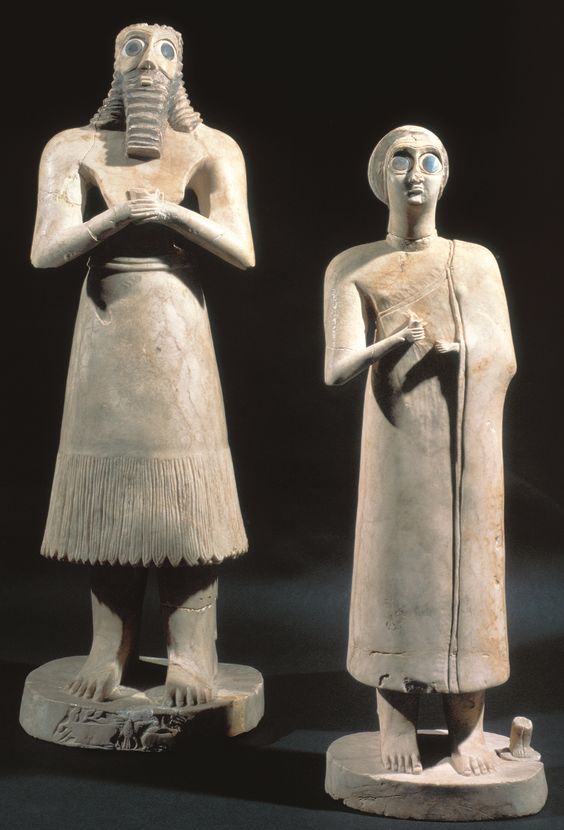
➼ Standard of Ur
Details
- From the Royal Tombs at Ur (modern Tell el-Muqayyar, Iraq)
- c. 2600–2400 B.C.E.
- A wood inlaid with shell, lapis lazuli, and red limestone
- Preserved in British Museum, London
Form
- Figures have broad frontal shoulders; bodies in profile; twisted perspective.
- Emphasis on eyes, eyebrows, ears.
- Organized in registers; figures stand on ground lines.
- Read from bottom to top.
- Ground line: a baseline upon which figures stand
- Ground plan: the map of a floor of a building
- Register: a horizontal band, often on top of another, that tells a narrative story
Content
- Two sides: war side and peace side; may have been two halves of a narrative; early example of a historical narrative.
- War side: Sumerian king, half a head taller than the others, has descended from his chariot to inspect captives brought before him, some of whom are debased by their nakedness; in the lowest register, chariots advance over the dead.
- Peace side: food brought in a procession to the banquet; musician plays the lyre; the ruler is the largest figure—he wears a kilt made of tufts of wool; may have been a victory celebration after a battle.
Context
- Found in a tomb at the royal cemetery at Ur in modern Iraq.
- Reflects extensive trading network: lapis lazuli from Afghanistan, shells from the Persian Gulf, and red limestone from India.
- Lapis lazuli: a deep-blue stone prized for its color
Theories
- It may have been part of a musical instrument's soundbox; the term "standard" comes from the idea that it was carried on a pole.
- The two scenes may show an ideal Sumerian ruler as a victorious general and a father who promotes general welfare.
Image
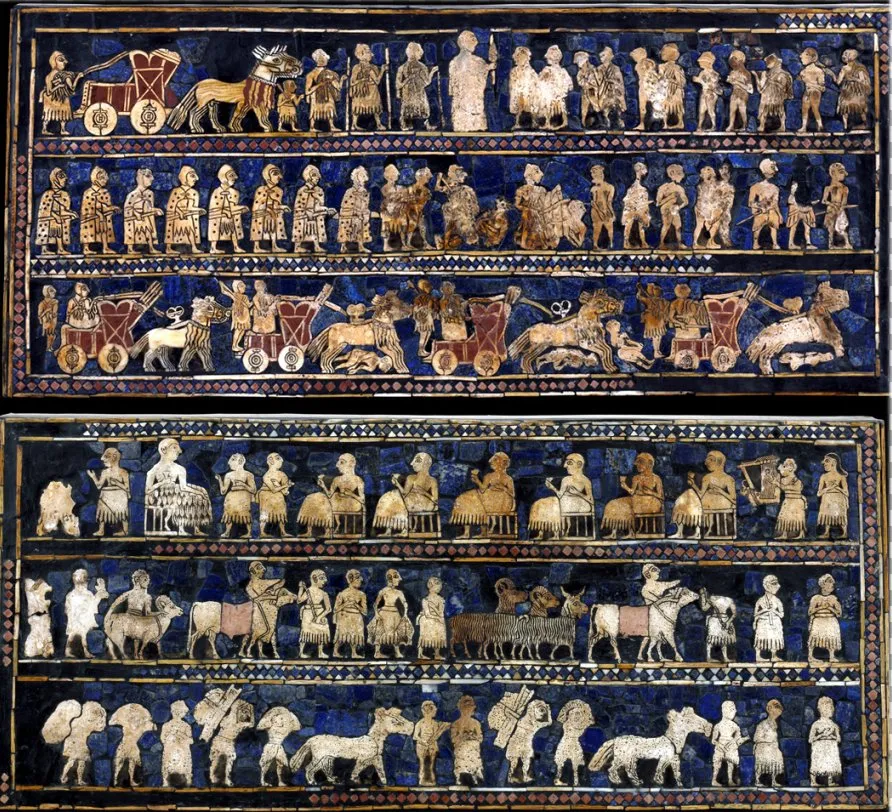
Babylonian Art
➼ Code of Hammurabi
Details
- From Babylon (modern Iran), Susian
- c. 1792–1750 B.C.E.
- Made up of basalt
- Found in Louvre, Paris
Form: A stele meant to be placed in an important location.
Function
- One of the earliest law codes is below the main scene, symbolizing a ruler's need to establish civic harmony in a civilized world.
- 300 law entries below the images symbolize Shamash giving Hammurabi the laws.
Content
- Shamash: Sun god, enthroned on a ziggurat, hands Hammurabi a rope, a ring, and a rod of kingship.
- Shamash is in a frontal view and a profile at the same time; their headdress is in profile; rays (wings?) appear from behind his shoulders.
- Shamash’s beard is fuller than Hammurabi’s, illustrating Shamash’s greater wisdom.
- Shamash, judge of the sky and the earth, with a tiara of four rows of horns, presents signs of royal power, the scepter and the ring, to Hammurabi.
- They stare at one another directly even though their shoulders are frontal; composite views.
- Hammurabi is depicted with a speaking/greeting gesture.
Context
- Written in cuneiform.
- Text in Akkadian language, read right to left and top to bottom in 51 columns.
- Law articles are written in a formula: “If a person has done this, then that will happen to him.”
History
- Hammurabi (1792–1750 B.C.E.) united Mesopotamia in his lifetime.
- Took Babylon from a small power to a dominant kingdom; after his death, the empire dwindled.
Image
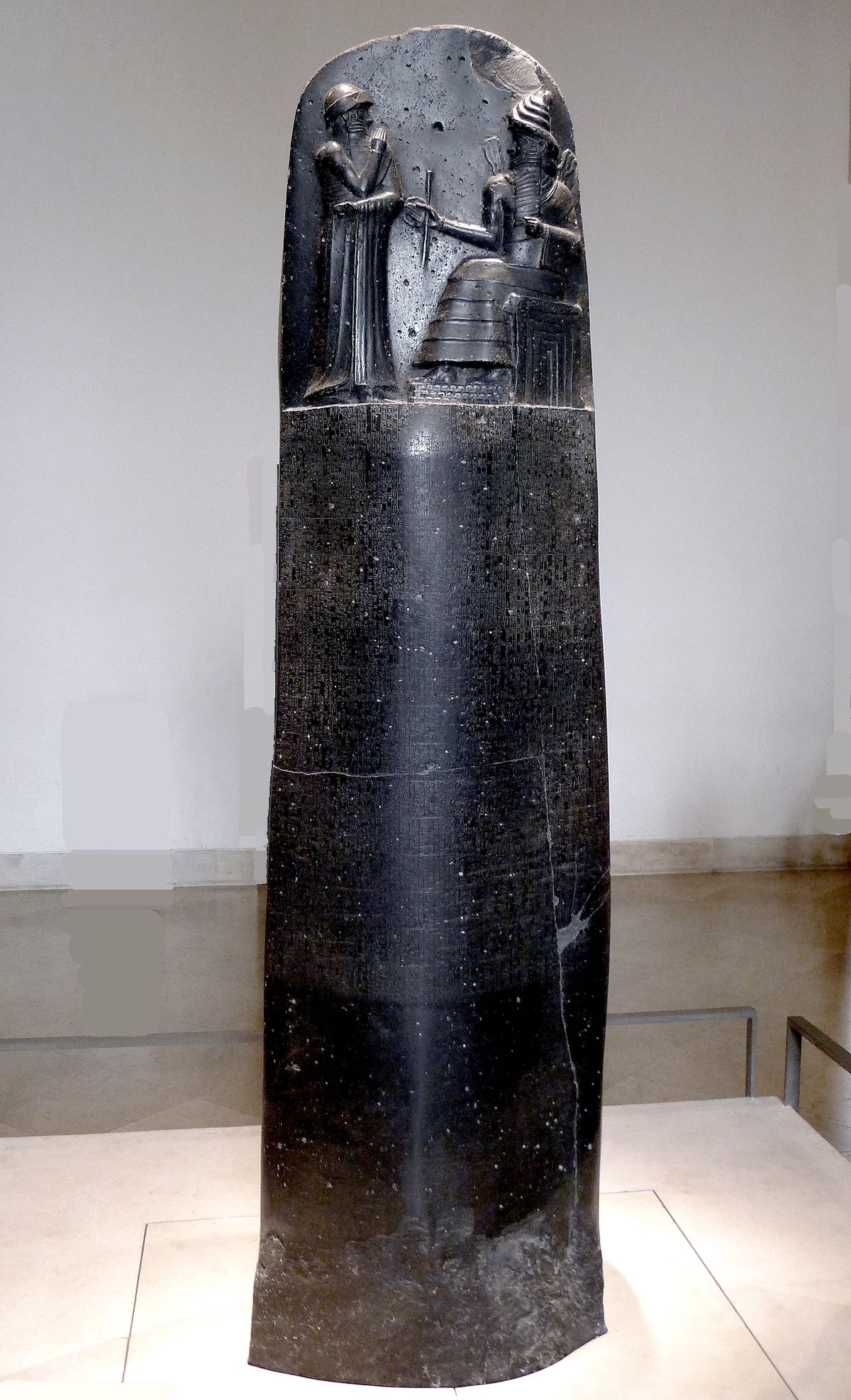
Assyrian Art
- Assyrian artists praised the greatness of their king, his ability to kill his enemies, his valor at hunting, and his masculinity.
- Figures are stoic, even while hunting lions or defeating an enemy.
- Animals, however, possess considerable emotion.
- Lions are in anguish and cry out for help.
- Shallow relief sculpture: an Assyrian specialty, although the lamassus are virtually three-dimensional as they project noticeably from the walls they are attached to.
➼ Lamassu
Details
- From the citadel of Sargon II, Dur Sharrukin (modern Khorsabad, Iraq)
- c. 720–705 B.C.E.,
- An alabaster
- Found in Louvre, Paris
Form
- Human-headed animal guardian figures: face of a person, ears and body of a bull.
- Winged.
- Appears to have five legs: when seen from the front, it seems to be standing at attention; when seen from the side, the animal seems to be walking.
- Faces exude calm, serenity, and harmony.
Materials
- Carved from a single piece of stone.
- Meant to hold up the walls and arch of a gate.
- Stone is rare in Mesopotamian art and contrasts greatly with the mud-brick construction of the palace.
Function
- Meant to ward off enemies both visible and invisible.
- Inscriptions in cuneiform at the bottom portion of the lamassu declare the power of the king and curse his enemies.
Context
- Sargon II founded the capital at Khorsabad; the city was surrounded by a wall with seven gates.
- The protective spirits (guardians) were placed at either side of each gate.
Image
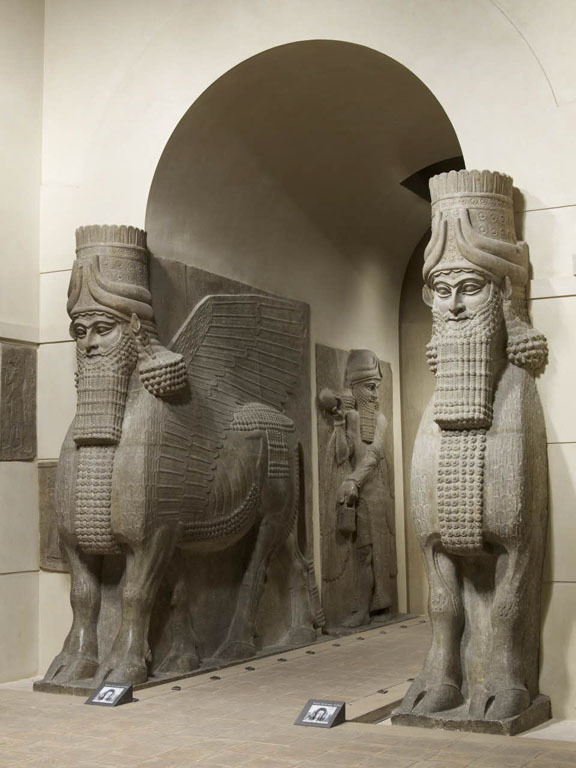
Persian Art
- Persia was the largest empire the world had seen up to this time.
- As the first great empire in history, it needed appropriate capital as a grand stage to impress people at home and dignitaries from abroad.
- Capital: the top element of a column
- The Persians erected monumental architecture, huge audience halls, and massive subsidiary buildings for grand ceremonies that glorified their country and their rulers.
- Persian architecture is characterized by columns topped by two bull-shaped capitals holding up a wooden roof.
➼ Apadana of Darius and Xerxes
Details
- c. 520–465 B.C.E.
- Mainly made up of limestone
- Found in Persepolis, Iran
- Apadana: an audience hall in a Persian palace
Form
- Built on artificial terraces, as is most Mesopotamian architecture.
- Columns have a bell-shaped base that is an inverted lotus blossom; the capitals are bulls or lions.
- Everything seems to have been built to dwarf the viewer.
Function
- Built for lavish receptions and festivals, not palaces.
- Lamassu gates welcome visitors.
- The Gates of All Nations proudly proclaim this complex as the seat of a great empire.
- Audience hall (apadana): It had 36 columns covered by a wooden roof; held thousands of people; was used for the king’s receptions; had stairways adorned with reliefs of the New Year’s festival and a procession of representatives of 23 subject nations.
- Hypostyle hall: An indication of one of the many cultures that inspired the complex.
Material: Mud brick with stone facing; stone symbolizing durability and strength.
Context and Interpretation
- Darius chose this central location in Persia to protect the treasury, and relief sculptures show delegations from across the empire bringing gifts for storage.
- The immortals, the king's guard, originally painted and adorned with metal accessories, were carved into the stairs.
- The stairs have a central relief of the king enthroned with attendants, the crown prince behind him, and dignitaries bowing.
- Static processions represent a peaceful world.
History
- Built by Darius I and Xerxes I; destroyed by Alexander the Great, perhaps as an act of revenge for the destruction of the Acropolis in Athens.
- Many cultural influences (Greeks, Egyptians, Babylonians) contributed to the building of the site, as a sign of Persian cosmopolitan imperial culture.
Image
